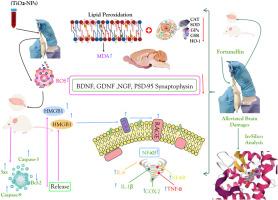Neuroprotective potential of fortunellin against titanium dioxide nanoparticles induced neurotoxicity via regulating NLRP3, HMGB1/RAGE, and NF-κB pathway: A biochemical, histological and in-silico experimentation
IF 2.4
4区 医学
Q2 PHARMACOLOGY & PHARMACY
引用次数: 0
Abstract
Titanium dioxide nanoparticles (TiO2-NPs) are widely used in the production of various industrial and commercial products and reported to cause neurotoxicity in Sprague Dawley rats. Fortunellin (FRN) is a potent flavonoid with diverse biological properties. This research was performed to explore the protective role FRN against TiO2-NPs induced brain damage. Thirty-six male Sprague Dawley rats were categorized into control, TiO2-NPs (120 mgkg−1), TiO2-NPs (120 mgkg−1) + FRN (20 mgkg−1), and FRN (20 mgkg−1) alone treated group. TiO2-NPs significantly (p < 0.001) provoked the expressions of High-Mobility Group Box 1 (HMGB1) (4.1-fold), NLRP3 inflammasome (3.7-fold), nuclear factor-kappa B (NF-κB) (4.4-fold), interleukin-6 (IL-6) (4.0-fold), Receptor for Advanced Glycation End products (RAGE) (3.9-fold), Cyclooxygenase-2 (COX-2) (3.5-fold), Interleukin-1 beta (IL-1β) (4.1-fold), and Tumor necrosis-factor-alpha (TNF-α) (4.6-fold) in brain tissues. The enzymatic activities of HO-1 (52 %), GPx (43 %), SOD (49 %), GST (46 %), CAT (41 %), and GSR (45 %) along with contents of GSH (57%) were suppressed (p < 0.001) while the levels of ROS (2.8-fold) and MDA (3.2-fold) were promoted substantially (p < 0.001) after TiO2-NPs intoxication. Moreover, brain health was compromised after TiO2-NPs exposure which is evident by reduced concentrations of Nerve growth factor (NGF) (58 %), Synaptophysin (63 %), Glial cell line derived neurotrophic factor (GDNF) (54 %), Postsynaptic density 95 (PSD-95) (49 %), and Brain-derived neurotrophic factor (BDNF) (61 %). Besides, TiO2-NPs administration significantly (p < 0.001) increased the levels of Caspase-9 (3.2-fold), Bax (2.9-fold), and Caspase-3 (3.5 %) while reducing the level of Bcl-2 (55 %). Histological semi-quantitative scoring revealed that TiO2-NPs caused severe cortical and hippocampal degeneration (Injury score: 2.7 ± 0.2 vs 0.3 ± 0.14 in control; p < 0.001). However, FRN concurrent supplementation remarkably alleviated aforementioned alterations, restoring antioxidant enzyme’s levels by 35–62 %, reducing inflammatory gene’s expression by up to 72 %, improving neurotropic factors level by 45–58 % and reducing apoptotic indices by 61–69 % (p < 0.01). FRN shows promising result as a neuroprotective agent in rats, warranting further clinical research.

通过调节NLRP3、HMGB1/RAGE和NF-κB通路,fortunellin对二氧化钛纳米颗粒诱导的神经毒性具有神经保护作用:生化、组织学和计算机实验。
二氧化钛纳米颗粒(TiO2-NPs)用于各种工业和商业产品的生产,据报道,二氧化钛纳米颗粒会对斯普拉格道利大鼠产生神经毒性。Fortunellin (FRN)是一种具有多种生物学特性的强效类黄酮。本实验旨在探讨FRN对TiO2-NPs脑损伤的保护作用。将36只雄性Sprague Dawley大鼠分为对照组、TiO2-NPs (120 mg -1)组、TiO2-NPs (120 mg -1) + FRN (20 mg -1)组和FRN (20 mg -1)处理组。TiO2-NPs显著(p < 0.001)刺激脑组织中高迁移率组框1 (HMGB1)(4.1倍)、NLRP3炎性小体(3.7倍)、核因子κB(4.4倍)、白细胞介素-6 (IL-6)(4.0倍)、晚期糖基化终产物受体(RAGE)(3.9倍)、环氧化酶-2 (COX-2)(3.5倍)、白细胞介素-1β (IL-1β)(4.1倍)和肿瘤坏死因子α (TNF-α)(4.6倍)的表达。TiO2-NPs中毒后,HO-1(52%)、GPx(43%)、SOD(49%)、GST(46%)、GSH(57%)、CAT(41%)和GSR(45%)的酶活性被抑制(p < 0.001), ROS(2.8倍)和MDA(3.2倍)的浓度被显著提高(p < 0.001)。此外,暴露于TiO2-NPs后,大脑健康受到损害,明显表现为神经生长因子(NGF)(58%)、突触素(63%)、胶质细胞系衍生神经营养因子(GDNF)(54%)、突触后密度95 (PSD-95)(49%)和脑源性神经营养因子(BDNF)(61%)的浓度降低。此外,TiO2-NPs处理显著(p < 0.001)加重了Caspase-9(3.2倍)、Bax(2.9倍)和Caspase-3(3.5%),同时降低了Bcl-2(55%)。组织学评分显示TiO2-NPs引起严重的皮质和海马变性(损伤评分:2.7±0.2 vs 0.3±0.14,对照组,p < 0.001)。然而,同时添加FRN可显著缓解上述变化,抗氧化酶水平恢复35-62%,炎症基因表达降低高达72%,神经营养因子水平提高45-58%,凋亡指数降低61-69% (p < 0.01)。FRN作为大鼠神经保护剂显示出良好的效果,值得进一步研究。
本文章由计算机程序翻译,如有差异,请以英文原文为准。
求助全文
约1分钟内获得全文
求助全文
来源期刊

Toxicon
医学-毒理学
CiteScore
4.80
自引率
10.70%
发文量
358
审稿时长
68 days
期刊介绍:
Toxicon has an open access mirror Toxicon: X, sharing the same aims and scope, editorial team, submission system and rigorous peer review. An introductory offer Toxicon: X - full waiver of the Open Access fee.
Toxicon''s "aims and scope" are to publish:
-articles containing the results of original research on problems related to toxins derived from animals, plants and microorganisms
-papers on novel findings related to the chemical, pharmacological, toxicological, and immunological properties of natural toxins
-molecular biological studies of toxins and other genes from poisonous and venomous organisms that advance understanding of the role or function of toxins
-clinical observations on poisoning and envenoming where a new therapeutic principle has been proposed or a decidedly superior clinical result has been obtained.
-material on the use of toxins as tools in studying biological processes and material on subjects related to venom and antivenom problems.
-articles on the translational application of toxins, for example as drugs and insecticides
-epidemiological studies on envenoming or poisoning, so long as they highlight a previously unrecognised medical problem or provide insight into the prevention or medical treatment of envenoming or poisoning. Retrospective surveys of hospital records, especially those lacking species identification, will not be considered for publication. Properly designed prospective community-based surveys are strongly encouraged.
-articles describing well-known activities of venoms, such as antibacterial, anticancer, and analgesic activities of arachnid venoms, without any attempt to define the mechanism of action or purify the active component, will not be considered for publication in Toxicon.
-review articles on problems related to toxinology.
To encourage the exchange of ideas, sections of the journal may be devoted to Short Communications, Letters to the Editor and activities of the affiliated societies.
 求助内容:
求助内容: 应助结果提醒方式:
应助结果提醒方式:


